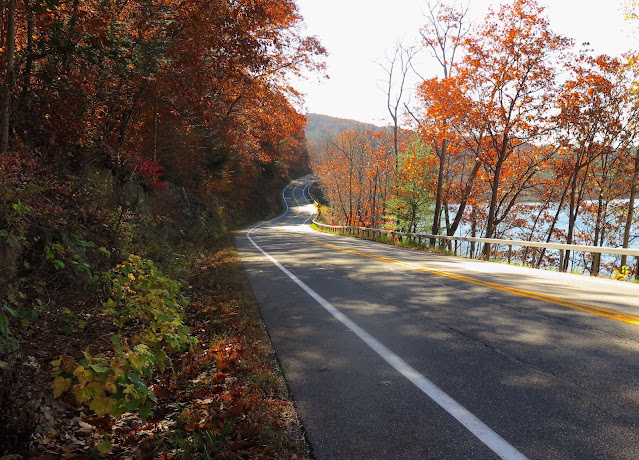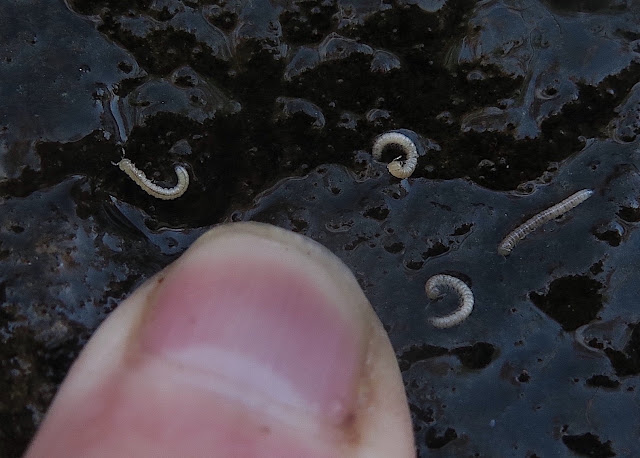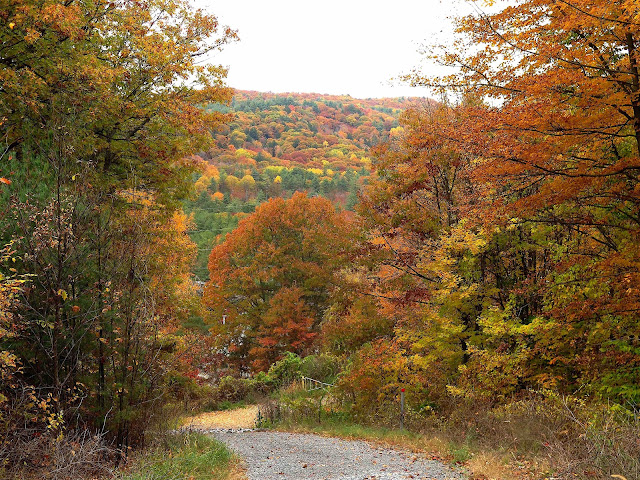"Pilgrimage" is indeed a word I would use to describe my annual autumn paddle on Lens Lake, an isolated, quiet body of water surrounded by mountains, made especially beautiful this time of year by colorful fall foliage. The word means "a journey to some sacred place as an act of spiritual devotion," and that definition certainly conveys how I always feel about visiting Lens Lake.

The soothing kindness of this calm, warm day, the spectacular beauty of the landscape, and the ease of silently slipping my boat through crystal-clear, smooth-as-silk water certainly amplified my personal belief in a God, not as that far-off "old guy in the sky" I learned about in Sunday School, but rather as the ever-present inherent source of all "Great Goodness" that lies at the core of creation. Adding to my joy today was the companionship of my dear friends Sue Pierce and Ruth Brooks, who joined me to mosey slowly along the shrub-lined banks, and to nose our small canoes through the narrow channels of the acres of boggy islands this Adirondack lake is famous for.

I held Ruth especially close to my heart this day, aware of how she so recently has suffered great loss because of Nature's violence: the raging winds and waters of Hurricane Ian that destroyed much of her winter community on Sanibel Island, Florida. Not only had Ruth lost her beach-front house, but also her life there with long-time friends and neighbors, who had joined her in working to preserve the fragile environment of that barrier island. I did so hope that Ruth might find some comfort and reassurance here, among the peaceful beauty of this day and place.
The shoreline trees were certainly doing their bit to amplify the splendor here, their vividly colored leaves so beautifully reflected by the shimmering water.
On every sphagnum-carpeted bogmat, white tufts of Cottongrass seedheads danced and bobbed with the slightest waft of a gentle breeze.
Clusters of Northern Pitcher Plant leaves (Sarracenia purpurea) had achieved their maximum ruby-red saturation.
Two different species of sphagnum moss mingled their vibrant Persian-carpet colors of red and gold on a hummock.
After so much brilliant color surrounding us, the soft pink of this shoreline mound of Small Red Sphagnum (Sphagnum capillifolium) seemed almost restful to my eyes. Feathery tufts of lime-green Brocade Moss (Hypnum imponens) poked up through the sphagnum's small, round, compact heads.
The soft-gray filigree of these spent flower clusters of Leatherleaf shrubs (Chamaedaphne calyculata) also contributed their quieter beauty to the shoreline.
As we paddled close to these thickets of Sheep Laurel (Kalmia angustifolia), we were delighted to see bright-pink flowers among the green and yellowing leaves.
Here's a closer look at those Sheep Laurel flowers, a remarkable sight this time of year, since this species of laurel first blooms in June. But we often do find Sheep Laurel blooming again each fall, here on Lens Lake, at least.
What looked like tiny pink "pinecones" at the ends of Labrador Tea twigs are not buds that will burst into bloom this fall. These cone-like structures are actually the protective winter bud scales that will fall away in spring to release this shrub's clusters of small white flowers. Meanwhile, they look quite pretty crowning the clusters of bright-green in-rolled leaves.
The sun grew so warm by midday that we were glad to seek shade at the back of this quiet cove, where we pulled in close to shore to eat our lunches and gaze with wonder at this gorgeous view.
Each fall when I come to paddle Lens Lake, I hope to see the Merganser family I have often seen before at this very time of year. In other years, I have found them arrayed atop a large boulder, as if posing for their portrait. This year, however, they kept their distance and were constantly on the move, well out of reach of my camera's best zoom range. I was nevertheless delighted to see them, just as we were about to leave.
Here is my favorite pose of Mergansers at Lens Lake, taken some years ago. I doubt the members of this family are the same individuals every year, since I assume it's a mom and her maturing brood. But I am amazed that I see a similar family each year, the rusty brown of their head feathers so compatible with all the autumn colors that surround them.

Before I drove home, I continued along the lakeshore road until I reached the end of the lake, delighting in the spectacle of autumn foliage along the road.
When I parked along the road, these pretty pink Sand Jointweed flowers (Polyganella articulata) greeted me as I stepped from my car to the sandy verge.
In the forest that crowded close to the road, I could see so many different and beautiful denizens of the Adirondacks. Here in this limited stretch of roadway I spied the glossy red-turning leaves of Northern Wild Raisin (Viburnum cassinoides), the warm-brown fronds of fading Cinnamon Fern (Osmundastrum cinnamomeum), the butter-yellow autumn leaves of Striped Maple (Acer pensylvanicum), and the soft evergreen needles of an EasternWhite Pine (Pinus strobus).
And what could be more quintessential of autumn in the Adirondacks than the blazing-red leaves of Red Maple (Acer rubrum) and the glossy dark-green needles of a Balsam Fir (Abies balsamea)? I only wish I could share the scent of those balsam needles warmed by the afternoon sun. Heaven!
































































